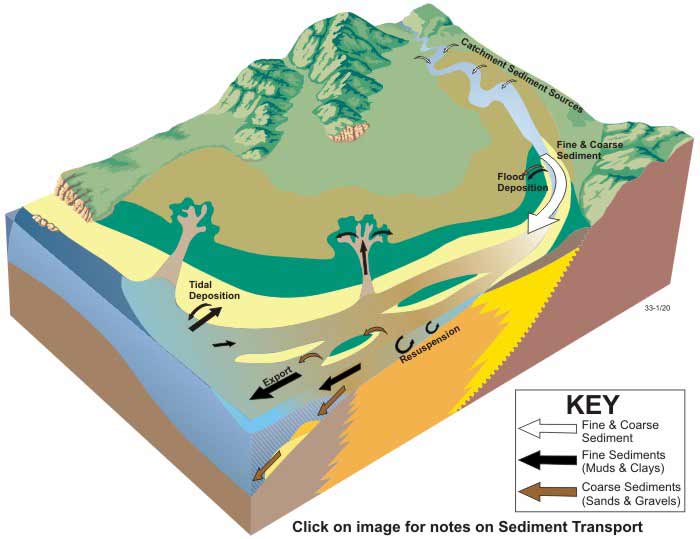
Sediment transport processes in tide-dominated deltas
1. Sediment inflow from catchment
Fine and coarse sediment enters the delta from the catchment. River flow and sediment supply vary regionally, depending on local catchment and climatic conditions, and the volume of river input. However, the input of catchment-derived sediment into estuaries and deltas is typically high.
2. Deposition of fine sediment
Limited deposition of fine sediment (including clays, muds and organic material) occurs upon the floodplain during high flow events (Jones et al., 1993). This is enhanced by the baffling effects of floodplain vegetation associated with swamp and marsh areas, and leads to slow vertical accretion of the floodplain. Some lateral deposition of sediment can occur, including the development of coarse sediment point-bar deposits.
3. Suspended sediment
Large quantities of suspended sediment are characteristic of tide-dominated deltas; strong tidal currents continually resuspend and rework fine sediment in the channels, so that the water column is naturally highly turbid (Turner et al., 1994, Wells, 1995). Fine suspended sediment, and coarse sediment as bedload, is moved downstream along the bottom of the deltaic channels. Quantities of fine and coarse sediment can pool temporarily within the channel, forming tidal sand banks. A zone of abnormally high suspended sediment can occur in many tide-dominated deltas, known as the ‘turbidity maximum’ (Wells, 1995). This typically transient feature develops as a result of trapping and resuspension of particles, and contributes to the deposition of material in the tidal sand banks. Ebb and flood tides can follow mutually-evasive channels which periodically migrate, and deposition typically does not occur at the bottom of channels due to scouring by strong currents (Nichols 1999, Green et al., 2000, Harris, 1988).
4. Deposition and erosion of fine sediment
Fine sediment undergoes both deposition and erosion on the extensive intertidal flats (Dyer, 1998, Woodroffe et al., 1999, Masselink et al., 2000). Deposition is aided by biological activity such as burrowing and improved cohesiveness (Ruddy et al., 1998, Murray et al., 2002), whereas erosion is typically related to storms and tides (Dyer, 1998). Coarser material is also deposited on flanking environments by tidal currents and flood events. Over time, intertidal flats tend to expand seawards (Nichols 1999, Green et al., 2001).
. Mangrove environments
Mangrove environments, with interspersed tidal drainage channels, commonly flank tide-dominated deltas, and serve as a depocentre for fine sediment. Tidal asymmetry (high energy flood and lower energy ebb tides), baffling by mangrove vegetation, and percolation of tidal water through animal burrows result in rapid deposition of fine sediment and organic material (Bowers et al., 1997, Alongi et al., 2001). Over time, mangrove environments tend to expand onto, and replace intertidal flats (Woodroffe et al., 1999).
6. Saltflat environments
Saltflat environments experience inundation only during king tides, during which some deposition of fine sediment occurs (Flood et al., 1986). Sediment in supra-tidal regions (including the floodplain) is mostly mud, which is deposited during high tides or river floods (Roy et al., 1981). Ebb tide waters often flow back to the main estuarine channel through tidal drainage channels.
7. Sediment exchange at the delta mouth
The majority of deposition occurs seaward of the delta mouth, and results in the export of sediment into the marine environment (Jones et al., 1993). Fine suspended sediment is generally transported offshore, whereas coarser sediment tends to accumulate close to the entrance, forming an ebb-tidal delta. Quantities of coarse sediment can pool within the channel, forming tidal sand banks, and result in the seaward expansion of intertidal habitats. The sediment trapping capability of tide-dominated deltas is therefore moderate to low, as most sediment is flushed through the deltaic channels and deposited into the ocean (Harris et al., In Press).


